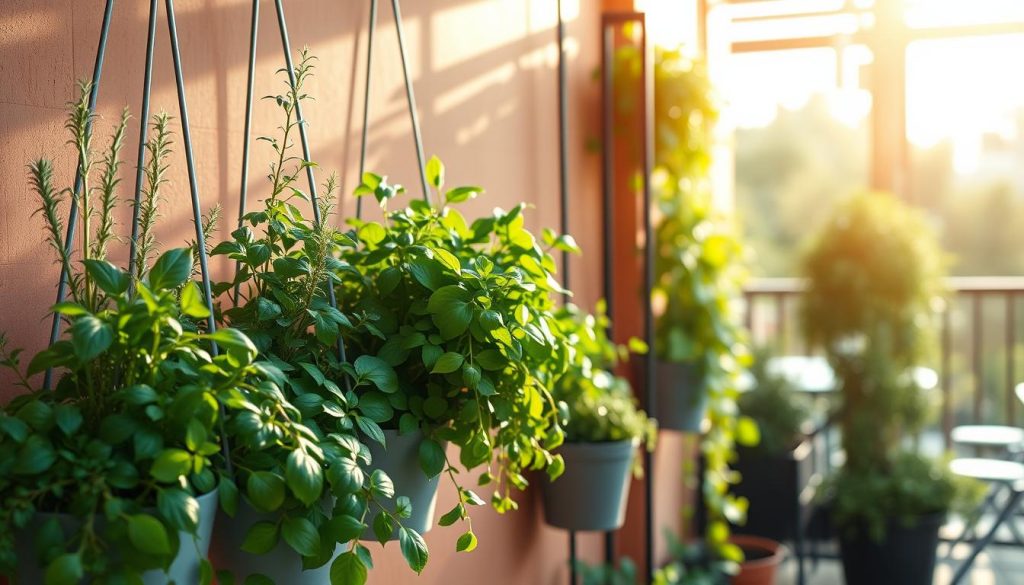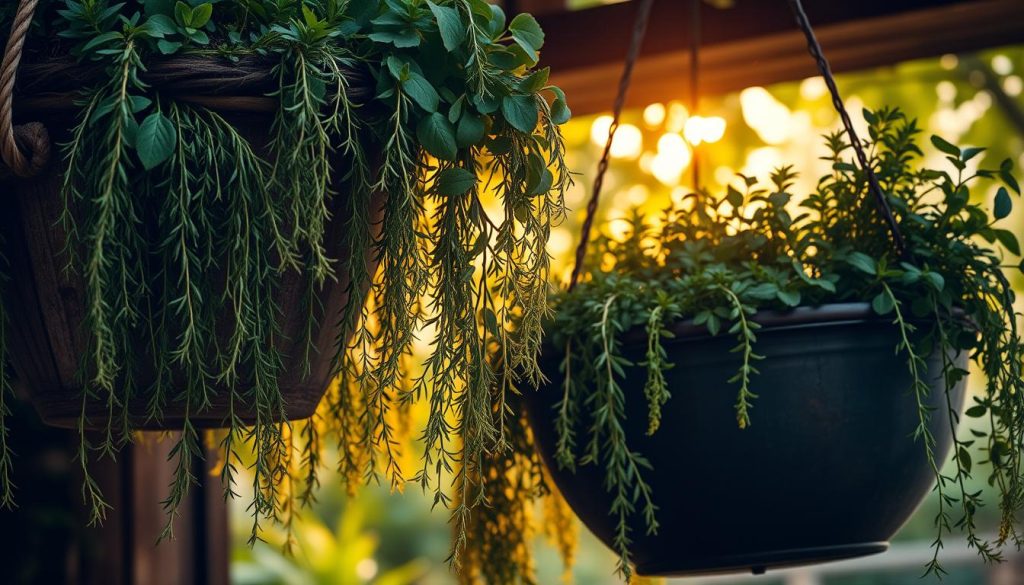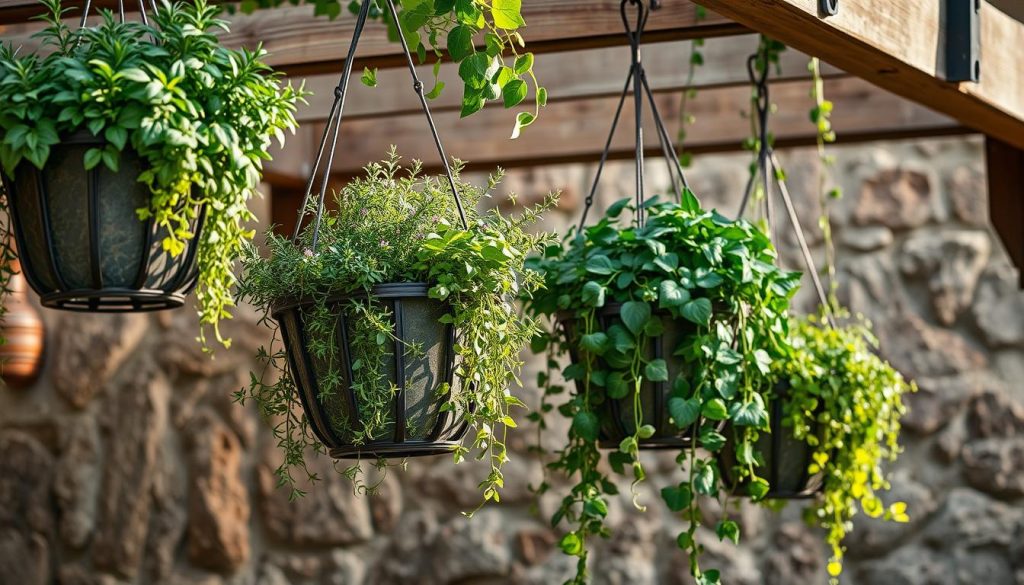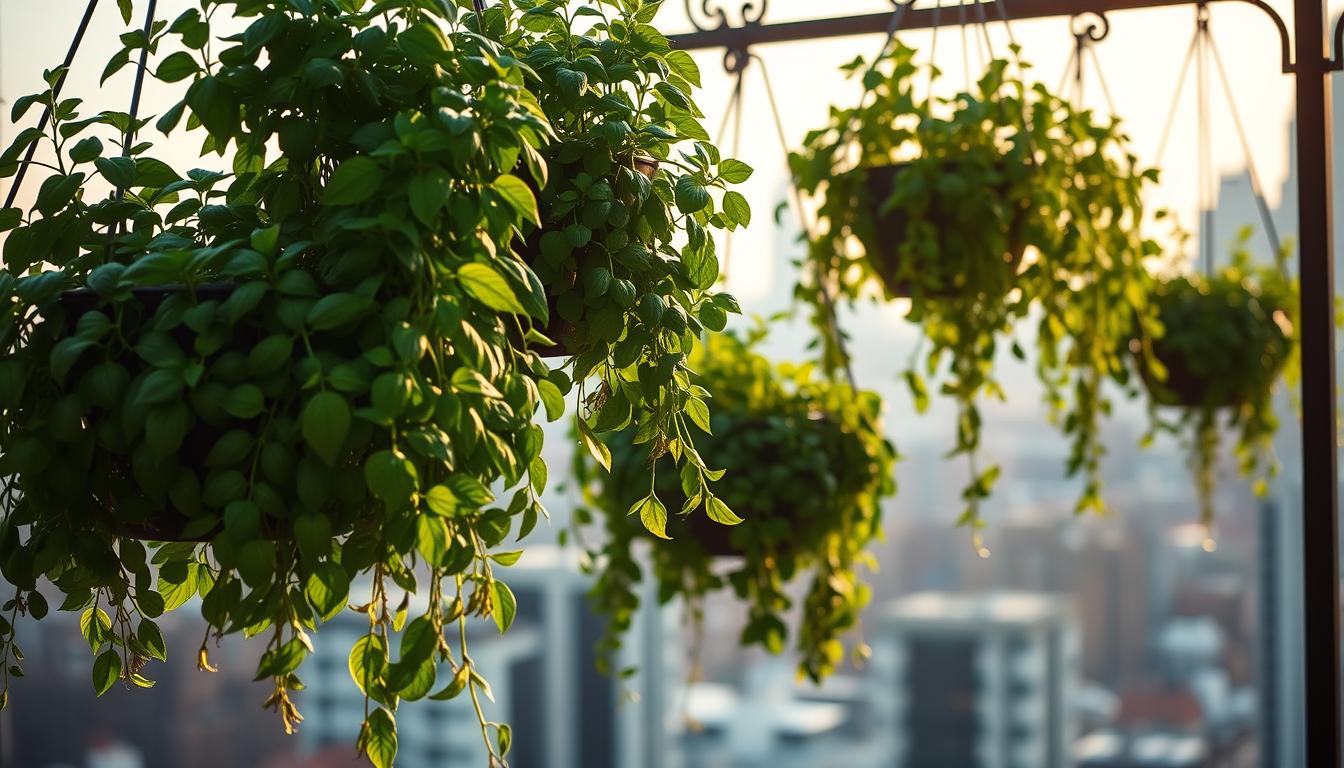My journey with hanging herb gardens started three years ago in my small apartment kitchen. I had little counter space for cooking. So, I found a creative way to grow fresh herbs by hanging them from my ceiling and walls.
These space-saving plants do more than just save space. There’s joy in picking fresh basil for pasta or mint for drinks right from your kitchen wall. Even in tiny spaces, these gardens make rooms feel lush and inviting.
Vertical gardening is perfect for both new and seasoned plant lovers. You don’t need a big backyard or perfect conditions to grow herbs all year. My collection started with three herbs and has grown into a beautiful display that everyone loves.
These living walls bring nature inside and keep cooking essentials close. Whether you have a small studio or a big house, they’re a great addition. Let’s dive into how to make, care for, and enjoy these beautiful home features.
The Transformative Power of Vertical Herb Gardening
When I first hung herbs from my kitchen ceiling, I didn’t expect the big change it would bring. Vertical herb gardening is more than saving space. It changes how we connect with plants at home. Hanging herbs opens up new ways to garden that old methods can’t match.
Starting my hanging herb garden was a smart move for my small kitchen. It turned out to be the best way to grow fresh, tasty herbs indoors.
Why I Believe Herbs Thrive Better in Vertical Spaces
After trying many things, I found that herbs grow better up high. They get better air flow, which helps them avoid diseases that can hurt them in pots.
My basil used to get wet and mildewy on the windowsill. But once I hung it up, it thrived. Herbs like thyme, oregano, and mint love to grow down, not out.

Light is key for herbs. Hanging them gets them more sunlight. My rosemary, for example, is now more compact and fragrant when it’s up high.
The Unmatched Blend of Function and Beauty
Hanging herb gardens are special because they’re both useful and beautiful. The way different herbs hang creates a stunning display. The colors change with the seasons, adding to the beauty.
My kitchen is now a hit with guests because of the herbs. They’re amazed by the look and smell of the herbs. Touching the herbs releases their scent, making the room smell great.
This mix of usefulness and beauty isn’t just for the kitchen. I’ve also put herb gardens in my office. They make the air better and add a calming touch to the room.
| Aspect | Traditional Horizontal Herbs | Vertical Hanging Herbs | Benefit Difference |
|---|---|---|---|
| Space Efficiency | Requires counter or floor space | Utilizes unused vertical space | Up to 3x more herbs in same footprint |
| Air Circulation | Often limited, even in crowded spots | 360° air flow around plants | Less disease, stronger plants |
| Light Exposure | Plants can shade each other | Even light for all plants | Plants grow better, taste better |
| Aesthetic Impact | More functional | Looks good and works well | Changes spaces, adds herbs |
Why Hanging Herb Gardens Are the Solution for Modern Living
As homes get smaller, hanging herb gardens are a great solution. The average home size has dropped, and urban apartments are shrinking by nearly 10%. This means we need creative ways to grow herbs without losing space.
Maximizing Limited Square Footage in Today’s Homes
Modern living often means using every inch wisely. Traditional herb gardens take up a lot of space, which many of us can’t spare. Hanging herb gardens use vertical space, making the most of what’s available.
In my 650-square-foot apartment, I found a way to garden vertically. I installed hanging planters near my kitchen window. This created a lush herb garden without taking up any counter or floor space. These herbs add flavor to my cooking and decorate my kitchen.

Choosing the right spot is crucial for saving space. Here are some great places for hanging herb gardens:
- Above kitchen sinks where natural light often streams in
- From curtain rods using lightweight planters
- Along balcony railings with secure attachments
- From ceiling hooks in bright corners
- Mounted on walls with specialized vertical planters
Creating Personal Green Sanctuaries in Urban Environments
Hanging herb gardens do more than save space. They bring a touch of nature into our lives. Studies show that indoor plants can lower stress by up to 15% and boost well-being.
Checking on my herbs every morning is a calming ritual. It connects me to nature and adds joy to my day. The scents and sights of fresh herbs are a refreshing break from screens and concrete.
Urban living can make us feel disconnected from nature. Tending to herbs brings us back to nature’s rhythms. Visitors to my apartment often comment on the peaceful, lively feel of my herb garden.
| Aspect | Traditional Herb Garden | Hanging Herb Garden | Space Savings |
|---|---|---|---|
| Floor Space Required | 4-10 square feet | 0 square feet | 100% |
| Accessibility | Requires bending/kneeling | Eye-level access | Improved ergonomics |
| Light Optimization | Limited to available ground space | Can be positioned near windows | Better light utilization |
| Visual Impact | Horizontal spread | Vertical visual interest | Enhanced room aesthetics |
My Top Herb Selections for Hanging Gardens
Choosing the right herbs is key to a stunning edible wall garden. Over the years, I’ve found the best herbs for hanging planters. They not only give a bountiful harvest but also add beauty and fragrance to any space.
I’ve sorted my favorite herbs by their growth habits and space needs. This helps you create a hanging herb garden that looks great and is productive. Whether you want herbs that cascade or are compact, these varieties will help you succeed.
Best Trailing Herbs That Create Visual Impact
Trailing herbs are the stars of any hanging garden. Creeping thyme is my top pick, with its tiny leaves and purple flowers. It creates a beautiful green curtain that adds color in summer.

Oregano, like Greek and Italian types, grows well in hanging planters. It can grow up to two feet, adding drama and flavor to your garden.
Mint is another great choice, but be careful. It grows fast, which is good in hanging planters. Chocolate mint, apple mint, and peppermint create stunning waterfalls of greenery.
Compact Herbs That Thrive in Confined Spaces
Not all herbs need to cascade. Some grow compactly, offering lots of flavor from little space. Dwarf basil, like ‘Spicy Globe’ and ‘Greek Columnar’, is a game-changer for vertical gardens.
Chives are essential in hanging gardens. They grow upright, adding texture and beauty. A small pot can give you enough chives for all year.
Compact sage varieties, like ‘Tricolor’ and ‘Purpurascens’, are also great. They look interesting and taste amazing, perfect for poultry and stuffings.
Unexpected Herbs That Have Surprised Me in Vertical Settings
Experimenting with herbs has led to some surprises. Rosemary, for example, does well in hanging planters, thanks to prostrate varieties. Use larger pots and good drainage.
Small vegetables can also be used as herbs in hanging gardens. ‘Tiny Tim’ tomatoes, for instance, can produce a lot from a single basket. This shows that edible wall gardens can include more than just herbs.
| Herb Type | Visual Impact | Space Requirements | Watering Needs | Culinary Uses |
|---|---|---|---|---|
| Creeping Thyme | Cascading mat with purple flowers | Minimal | Low | Meat dishes, soups, Mediterranean cuisine |
| Greek Oregano | Dramatic trailing habit | Medium | Low-Medium | Italian dishes, pizza, tomato sauces |
| Dwarf Basil | Compact, bushy growth | Small | Medium-High | Pesto, salads, Italian and Thai cuisine |
| Chives | Upright, grassy with purple blooms | Small | Medium | Garnish, potato dishes, eggs, soups |
| Prostrate Rosemary | Trailing woody stems with blue flowers | Medium-Large | Low | Roasted meats, breads, Mediterranean dishes |
Essential Materials for Creating Stunning Hanging Herb Gardens
Choosing the right materials is key to making your hanging herb gardens stand out. I’ve learned that the best vertical herb gardens come from careful material selection. The right mix of containers, soil, and support systems is crucial for herbs to thrive and add beauty to your space.
Container Options That Elevate Your Garden’s Style
The containers you pick are both functional and design elements. The ideal container balances drainage, growing space, and style that matches your decor.
At first, I didn’t realize how much the container choice affects plant health and looks. Now, I think about how each planter will look with herbs and how it fits with my design.

Commercial baskets and planters are reliable and consistent. They have built-in drainage and hanging systems for plant success. But, repurposed items like vintage colanders and tea tins add unique charm and reduce waste.
My kitchen herb wall with mismatched mugs always gets attention. It brings me joy every time I harvest fresh herbs.
Material Considerations for Longevity
Different materials work differently in hanging gardens. Plastic is light and keeps moisture, great for herbs that like it damp. Terracotta is heavier but lets soil breathe, preventing overwatering.
Metal adds industrial charm but can get hot in sun, stressing herbs. Fabric planters are my favorite for many herbs because they’re aeration-friendly and flexible. For living walls, specialized systems like felt or recycled plastic are best for support and look.
Soil Mixes That I’ve Found Support Vertical Success
Standard potting soil doesn’t work for hanging gardens. I learned that hanging containers need special soil that holds moisture but drains well.
I mix high-quality potting soil, coconut coir, and perlite in a 2:1:1 ratio. For dry-loving herbs, I add more perlite. For wet-loving herbs, I add more coconut coir.
Adding water-retaining polymer crystals per gallon of soil mix has been a game-changer. They absorb and release water slowly, reducing watering without risking root rot.
For living walls, I use specialized mixes with bark to prevent compaction. In hydroponic systems, I use soilless mediums like expanded clay pellets or rockwool for support and nutrient flow.
Switching to hydroponic systems was scary at first, but they’re low maintenance and produce vigorous herbs. They’re perfect for indoor gardens where water runoff is a problem.
Step-by-Step: Creating Your First Hanging Herb Garden
Let me guide you through making stunning hanging herb gardens. They can thrive in any home. You don’t need to be a gardening expert to get great results. With some planning and the right techniques, your vertical herb garden will be a highlight of your home.
Planning Your Vertical Garden Layout for Maximum Impact
Start by checking your space for light. Most herbs need 4-6 hours of sunlight daily. South or west-facing windows are best for hanging herb gardens.
Think about how easy it is to water and harvest your herbs. They should be reachable without needing a ladder. Sketch your space and mark where you can hang your garden.
When placing plants, consider their mature size. Use trailing herbs like thyme at the edges. Taller herbs like basil can go in the center. Group plants with similar water needs together for easier care.
Planting Techniques I Swear By for Lasting Success
Good planting techniques are key to a thriving garden. When moving plants to containers, gently loosen the roots. This helps them grow new roots and reduces shock. For tight roots, make vertical cuts to help them spread.
Plant herbs at the same depth as in their nursery pots. Avoid planting too deep to prevent stem rot. Leave about an inch of space at the top for watering.
For vertical gardens, place plants slightly off-center. This makes them cascade beautifully. This trick adds to the garden’s lush look.
Pairing plants is beneficial in hanging gardens. Mint with oregano keeps pests away, and basil with parsley grows well together. These pairs look good and help each plant thrive in tight spaces.
Hanging Systems That Won’t Compromise Your Space
The right hanging system is crucial. It can enhance your space or become a problem. I’ve tried many methods and found reliable options for different settings.
Ceiling hooks are traditional and let herbs cascade. Wall brackets offer more flexibility. Tension rod systems are great for renters or those who don’t want to damage walls.
Weight Considerations and Support Options
Remember the weight of your containers when full of water. A medium planter can weigh 15-20 pounds. Use hooks rated for twice the expected weight for ceiling installations. Anchor them into joists, not just drywall. Toggle bolts are good when joists are hard to reach.
Damage-Free Installation Methods
Use tension-mounted shower rods for lightweight planters. Heavy-duty command hooks are good for small pots. My favorite for renters is over-the-door systems that don’t need holes. Spring-tension curtain rods in windows also work well without leaving marks.
Maintaining Thriving Hanging Herb Gardens Through Every Season
Keeping hanging herb gardens lush and productive all year is key. Unlike regular gardens or pots, hanging herbs need special care. After trying many things, I found a way to keep my vertical herbs healthy all season.
Hanging containers face unique challenges. They dry out faster due to air movement and have less soil. But with the right care, these issues can be overcome, making gardening rewarding.
Watering Wisdom That Changed My Vertical Gardening Game
Watering is crucial for hanging herb gardens. They dry out quickly, needing water often in summer. Always check the soil an inch below the surface to see if it’s dry.
Bottom-watering changed how I care for indoor herbs. For small containers, I soak the bottom third in water for 10-15 minutes. This helps roots grow deep and prevents soil compaction.
For hard-to-move containers, I use a long-spouted watering can. This method stops water from running off and gets moisture to the roots. I also add water-retaining polymers to my soil, cutting down on watering by 40%.
Watering at the right time is important. I water in the morning so plants can absorb it before it gets hot. For indoor herbs, I watch for signs like wilted leaves to know when to water.
Seasonal Care Adjustments I’ve Learned Through Experience
My hanging herb gardens change with the seasons, so their care does too. In winter, they get less light and dry air. I rotate them weekly and use grow lights for 6-8 hours a day.
In winter, keeping the air humid is key. I group plants together and mist them occasionally. I also fertilize less, using half-strength organic fertilizer once a month.
Summer brings its own challenges. I move containers away from direct sun to prevent burning. For when I’m away, I use a self-watering system that lasts up to a week.
Pruning Strategies for Both Productivity and Visual Appeal
Pruning is essential for hanging herbs. It makes them look great and grow well. I pinch off tips often, which encourages bushy growth.
For herbs like thyme and rosemary, I prune them to grow in a certain direction. This keeps them looking balanced and creates a waterfall effect.
I harvest from the outside in to keep the plant looking good. For woody herbs, I never take off more than a third at once. This helps them recover.
| Season | Watering Frequency | Fertilization | Light Requirements | Special Considerations |
|---|---|---|---|---|
| Spring | Every 2-3 days | Bi-weekly (full strength) | Natural light sufficient | Begin regular pruning routine |
| Summer | Daily or twice daily | Weekly (half strength) | Protect from intense direct sun | Monitor for heat stress, increase humidity |
| Fall | Every 3-4 days | Monthly (full strength) | Reposition for changing sun angle | Harvest heavily before winter |
| Winter | Weekly | Monthly (half strength) | Supplement with grow lights | Increase humidity, reduce pruning |
Creative Placement Ideas That Revolutionize Home Herbalism
Hanging herb gardens open up new possibilities for your home. You can grow herbs in many places, not just the windowsill. I’ve tried different spots and found that herbs do well in unexpected places. This not only makes them easier to reach but also adds beauty to your home.
Kitchen Installations for Immediate Culinary Inspiration
My kitchen changed when I added hanging herbs. I put hooks and S-shaped hangers under cabinets for basil and thyme. This makes them easy to grab when I’m cooking.
A tension rod in a kitchen window is perfect for parsley and chives. If you have a kitchen island, try a suspended herb chandelier. I used a wooden ladder hung from the ceiling, making it a beautiful and useful herb garden.
Having herbs close to where I cook has changed my meals. Now, I add fresh flavors to my dishes easily, making them taste better.
Outdoor Spaces Completely Transformed by Hanging Herbs
My patio became a lovely spot after adding hanging herb planters. I built a vertical herb wall using gutters. It’s private and smells great with rosemary and lavender.
Mason jars on my fence with mint and lemon balm are charming and save space. On my covered porch, I made a herb mobile that sways in the breeze, filling the air with scents.
When picking herbs for outdoor spots, I think about the weather. My balcony is for Mediterranean herbs like oregano and sage. Shadier areas are for cilantro and parsley that don’t like the sun.
Unexpected Locations That Have Become My Favorite Herb Showcases
Herbs in the bathroom might sound odd, but it’s a great spot. The humidity is perfect for some herbs. My shower has mint and lemongrass, which love the steam.
In my office, a hanging garden on a decorative ladder adds beauty and helps me focus. Rosemary improves concentration, and lavender reduces stress.
Even my bedroom has herbs. Chamomile and lavender near my bed help me sleep better. These spots have made me appreciate herbs more than just for cooking.
| Location | Best Herbs | Benefits | Considerations |
|---|---|---|---|
| Kitchen Window | Basil, Thyme, Oregano | Immediate access while cooking | Ensure adequate light exposure |
| Bathroom | Mint, Lemongrass, Aloe | Natural humidity supports growth | May need supplemental lighting |
| Bedroom | Lavender, Chamomile, Lemon Balm | Aromatherapeutic benefits for sleep | Choose low-maintenance varieties |
| Outdoor Patio | Rosemary, Sage, Chives | Creates privacy and fragrance | Consider seasonal weather protection |
Advanced Techniques: Why I’m Passionate About Innovative Hanging Herb Gardens
I’ve become really excited about new ways to grow herbs vertically. What started with simple pots has turned into advanced systems. These systems make my home look great and help me grow more herbs.
Exploring advanced hanging herb techniques has been amazing. It’s not just about saving space. It’s also about growing more herbs and making my home look better.
Hydroponic Systems That Revolutionized My Indoor Herb Growing
Starting with hydroponics was like entering a new world of gardening. It’s a way to grow plants without soil, which is cleaner and faster. I started with simple setups and then moved to more complex ones.
The nutrient film technique really worked well for my herb walls. It uses a thin layer of nutrients to feed the roots. This method made my basil and cilantro grow better than ever.
- Water culture systems work best for herbs with smaller root systems like mint and oregano
- Wick systems require almost no maintenance, perfect for busy periods
- Nutrient film techniques produce the fastest growth for most culinary herbs
- Aeroponics creates the most robust root systems but requires more technical knowledge
Creating Living Herb Walls That Become Conversation Pieces
Going from single pots to living walls changed my gardening. These walls turned blank spaces into beautiful, productive areas. They always draw attention and start interesting conversations.
Building successful living walls needs careful planning. I learned to use good irrigation systems and choose herbs that grow well together. This way, every plant does well.
My best living wall uses different systems for different herbs. It has shallow pockets for thyme and deeper troughs for rosemary. This mix looks great and meets the needs of each herb.
My Experiments Combining Herbs with Flowers for Stunning Displays
Mixing herbs and flowers in hanging gardens is my favorite thing to do. These gardens are beautiful, attract good bugs, and give me food. They’re perfect for any room.
Trailing nasturtiums and creeping thyme look amazing together. They create a colorful display and offer edible flowers and leaves. The nasturtiums add a pop of color to the thyme.
Calendula and sage are another great mix. The bright flowers of calendula contrast with the sage’s green leaves. Both plants have health benefits. These gardens change and grow, keeping them interesting all year.
The Life-Changing Benefits of Embracing Hanging Herb Gardens
My journey with hanging herb gardens began as a way to save space. But it quickly became much more. Tending to my herb planters is now a special moment in my day.
It has changed how I cook. There’s nothing like using fresh basil or thyme from my garden. It makes me want to try new recipes and bring back old family traditions.
My vertical herb displays have started many conversations. Neighbors admire the thyme on my porch. Dinner guests often want to make their own herb planters after seeing mine.
But the biggest surprise is the calm it brings. Caring for these plants is a break from screens and stress. Watching them grow is incredibly fulfilling.
Trying hydroponic herbs was a new adventure. These systems let me grow herbs all year, even indoors. It’s amazing.
If you start with a small pot of mint or try hydroponics, I say go for it. It could become your favorite hobby. One that makes you feel good every day.

